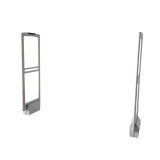RFID technology has revolutionized various industries with its efficiency and effectiveness. One key component of RFID technology is the RFID label, which offers numerous benefits in different sectors, ranging from retail to manufacturing. In this article, we will explore the advantages of RFID labels and their impact on businesses. So, let’s dive in and discover how RFID labels can transform the way industries operate.
What is an RFID label?

RFID labels, also known as radio frequency identification labels, are small adhesive tags that contain a microchip and an antenna. These labels use radio waves to transmit data to RFID readers, allowing quick and accurate data capture. RFID labels can be attached to various objects, such as products, inventory items, or assets, to track their movement and collect important information.
4 General benefits of RFID labels
RFID labels offer a wide range of benefits that can significantly improve operational efficiency and enhance business processes. Let’s explore some of these key advantages:
1. Efficient asset tracking
In industries where asset management is critical, such as healthcare or manufacturing, RFID labels can streamline the tracking of valuable assets. By tagging equipment, tools, or machinery with RFID labels, businesses can monitor their location, usage, and maintenance history. This prevents lost or misplaced assets, reduces equipment downtime, and optimizes maintenance schedules, leading to cost savings and improved operational efficiency.
2. Improved product authentication
Counterfeiting is a major concern in many industries, especially in the retail sector. RFID labels can help combat counterfeit products by providing a reliable means of product authentication. These labels can be embedded with unique identification codes or digital signatures that can be verified using RFID readers. This allows businesses and consumers to easily distinguish genuine products from counterfeit ones, ensuring customer trust and brand integrity.
3. Increased supply chain visibility.
With RFID labels, businesses can achieve end-to-end visibility in their supply chain. By tagging items at each stage of the supply chain, from manufacturing to distribution, companies can track the movement of goods, identify bottlenecks, and streamline logistics processes. This visibility allows for better decision-making, improved forecasting, and reduced errors or delays in delivering products to customers.
4. Enhanced customer engagement
RFID technology offers unique opportunities for businesses to engage and connect with their customers. With RFID-enabled loyalty cards or smart tags, customers can access personalized offers, discounts, or product information by simply tapping their card or device. This not only enhances the shopping experience but also allows businesses to gather valuable customer data and tailor their marketing strategies accordingly.
RFID Label benefits in retail

- Increased inventory accuracy: RFID labels enable retailers to track inventory in real-time, providing accurate and up-to-date information on stock levels. This helps reduce inventory errors, minimize out-of-stock situations, and improve overall inventory management.
- Streamlined checkout process: With RFID labels, retailers can implement quick and efficient checkout processes. RFID-enabled systems can read multiple items simultaneously, reducing the time customers spend at the checkout counter and improving the overall shopping experience.
- Theft prevention: RFID labels can be used for anti-theft purposes by setting off alarms if an item with an RFID label is taken out of a designated area without authorization. This helps prevent theft and enhances store security.
RFID label benefits in manufacturing

- Improved inventory management: RFID labels enable manufacturers to have real-time visibility into their inventory, making it easier to track raw materials, work-in-progress items, and finished goods. This ensures accurate inventory levels and reduces the risk of stockouts or overstock situations.
- Enhanced quality control: RFID labels can be used to track and monitor the quality of products throughout the manufacturing process. Manufacturers can attach RFID labels to components or sub-assemblies to ensure that quality standards are met at each stage, reducing the risk of defects or recalls.
- Streamlined production processes: These labels can automate production processes by providing real-time information about the status of materials, work orders, and production lines. This improves operational efficiency, reduces errors, and increases overall productivity.
Conclusion
RFID labels are transforming the way businesses operate, offering a wide range of benefits in both the retail and manufacturing sectors. Whether it’s improving inventory management, streamlining production processes, enhancing asset tracking, or increasing supply chain visibility, RFID labels are a powerful tool that can drive efficiency and productivity. By harnessing the power of RFID technology, businesses can stay ahead of the competition. However, they need to find a reliable RFID label supplier to enjoy all these benefits. Because the product qual
FAQs
1. What is the structure of an RFID label?
RFID labels have a basic structure that typically includes:
- Antenna: The antenna is a critical component of an RFID label. It’s often a thin, flat, conductive structure that can be printed, etched, or attached to the label. The antenna’s design and size affect the label’s performance, including its read range.
- RFID Chip: The RFID chip, also known as the integrated circuit (IC), contains memory and circuitry for communication. It stores the unique identifier and data that the RFID system reads. The chip connects to the antenna for communication.
- Substrate: The substrate is the material on which the antenna and RFID chip are placed. It can be paper, plastic, or another material, depending on the label’s intended use. The substrate provides the label with its physical structure and durability.
- Adhesive Layer: Many RFID labels have an adhesive layer on the back, allowing them to be attached to products or surfaces. The adhesive layer can be permanent or removable, depending on the application.
- Top Layer (Optional): In some cases, RFID labels have a top layer that provides protection and can be customized with printing or branding. This layer helps ensure the label’s longevity and visual appeal.
The RFID label’s specific design and components can vary based on its intended use, environmental conditions, and the capabilities of the RFID system it will be used with. RFID labels are employed in various industries for applications like inventory management, asset tracking, access control, and more.
2. Why RFID is better than a barcode?
RFID technology offers several advantages over traditional barcodes. Unlike barcodes, RFID does not require a line-of-sight scan, which means that multiple items can be read simultaneously and at a distance. This speed and efficiency make it ideal for inventory management and supply chain operations, where real-time data capture is essential. RFID tags are also more durable than barcodes and can withstand harsh environmental conditions, ensuring accuracy and longevity.
Additionally, RFID tags can store and transmit more data, allowing for better tracking and management of items. Overall, RFID technology offers increased efficiency, accuracy, and versatility compared to barcodes, making it a preferred choice for various industries and applications.
3. Can a barcode scanner read RFID?
No, a traditional barcode scanner cannot read RFID (Radio-Frequency Identification) tags. Barcodes and RFID use fundamentally different technologies for data capture and transmission. Barcode scanners use visible light to scan printed barcodes, while RFID readers use radio waves to communicate with RFID tags, which can be read at a distance without the need for a direct line of sight. To read RFID tags, you need a dedicated RFID reader or scanner that operates on the appropriate frequency and communication protocol for the RFID tags in use.
4. Can RFID be duplicated?
RFID tags can be duplicated, but it is generally a more complex process compared to duplicating traditional barcodes or magnetic stripe cards. Duplicating RFID tags typically requires specialized knowledge and equipment. There are various methods for RFID tag duplication, such as cloning the tag’s unique identification number or exploiting vulnerabilities in specific RFID systems. However, the ability to duplicate RFID tags may be subject to legal and ethical constraints, as well as the specific security measures in place for the RFID system.
Many RFID systems employ encryption and security features to prevent unauthorized duplication and access. Therefore, while it is possible to duplicate RFID tags, it is not a straightforward or widespread practice, and it is often discouraged due to privacy and security concerns.


































